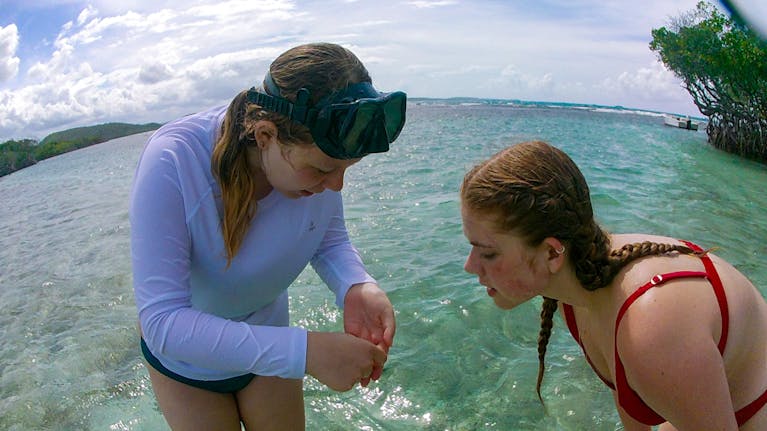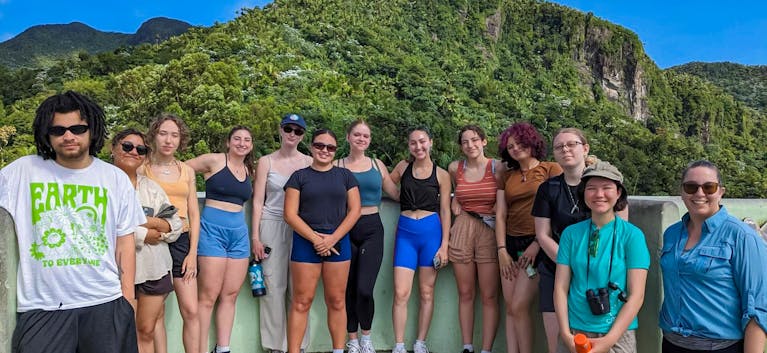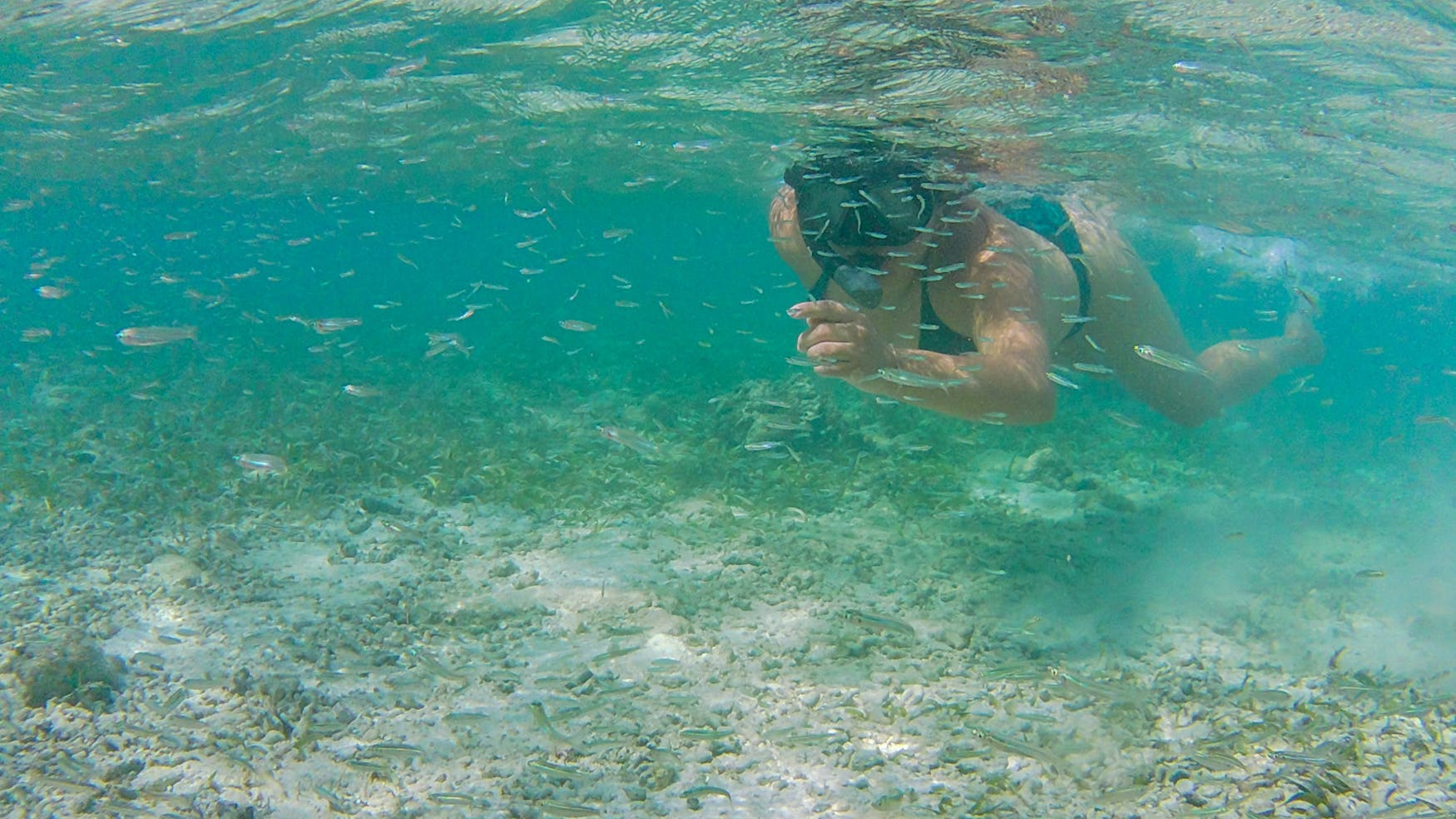Off the page and into the thick of it: First run of Puerto Rico study abroad program took students to see environmental effects of climate change
Three students in the Environmental Studies program reflect on their experiences while abroad in San Juan, Puerto Rico this summer.
This past summer, 12 students took their environmental studies to a new level as they explored the local landscapes of Puerto Rico. Associate Professor Sally Warner (ENVS) led the first study abroad program in San Juan, Puerto Rico where students stayed at the Universidad del Sagrado Corazón and studied with local faculty. The five week program hinged upon immersive learning and gave students interested in climate science an educational experience built into the Caribbean landscape.
The program, set to be offered in June of every even year, was created with consideration of Deferred Action for Childhood Arrival students, providing an opportunity to go abroad without a passport and fulfill the Applied Learning Experience requirement for the Environmental Studies major.
While in Puerto Rico, Warner taught an oceanography course similar to ENVS 21b, the oceanography course she teaches at Brandeis. “The difference was that instead of talking about coral reefs, we went and snorkeled on a very degraded coral reef,” Warner shared in an Aug. 29 interview with The Justice. Seeing a coral reef in such destructed condition proved eye opening for Warner, whose classes cover the effects of climate change on coral reefs from ocean acidification to coral bleaching. By integrating academic and cultural field trips into the coursework each week, the program gave students an experiential learning opportunity which is unique to the land.

In addition to enabling these hands-on experiences with the Puerto Rican ecosystems, one of Warner’s main goals for the students was to understand the environmental challenges of the region and contrast that from what they’ve learned in their classes while living in an ecologically different place like Massachusetts.
Climate change has had devastating consequences for the Caribbean island, from stronger hurricanes to eroding beaches that contribute to its rising sea level. These rising sea levels submerge marshes, dry land and mangroves. In light of these environmental plights that face the region, Warner noted the imperative for sustainable development — especially in its vulnerable state of recovery from a government financial crisis, Hurricane Maria, and then COVID-19
In conjunction with the oceanography course, students were able to learn about Puerto Rican perspectives in ENVS 25a, “Environmental Dimensions of Sustainable Development in Puerto Rico,” taught by Universidad del Sagrado Corazón Prof. Carlos Muniz Osorio. In Osorio’s sustainable development course, students learned firsthand the importance of the mangrove ecosystem among other topics related to resource depletion and pollution.
One of the biweekly field trips the class took into nearby communities was to the Las Mareas neighborhood, which flourishes both ecologically and economically on the local mangrove forests. This was a fascinating experience for Kira Rodriguez ’27, whose final report for Osorio’s course explored the interconnectedness of the Las Mareas community and its mangrove forests.
“They were just cut at half height,” she said in a Sept. 1 interview with The Justice, recounting her experience seeing the damaged mangroves. Something about the image of these trees stuck in a slow recovery resonated with Rodriguez. “It was like a bunch of little sticks, the size of your finger [...] there was like flourishing greenery, but there’s just one section that’s half the height,” she continued.
Each member of the abroad program has their own preferences about which path in the environmental sciences they intend to go down, whether that’s something they’ve always known or are still navigating. Rodriguez is interested in human to environment interaction: “I was extremely excited about ‘Environmental Dimensions of Sustainable Development,’ because for me, environmental dimensions, sustainable development means the people to environmental interaction, which is what I want to focus on with my environmental degree.”
Being half Puerto Rican and having family that lives on the island, this was not Rodriguez’ first visit to Puerto Rico. While Rodriguez was already a Spanish speaker, she realized while taking the Spanish language and Puerto Rican culture course held during the first week that she spoke a different dialect of the language. She ended up learning a lot and enjoying the immersion experience.

“The very last day of the course, our teacher gave us her contact information so if we’re ever back on the island, she would want to hang out,” Rodriguez recalled. She continued, “That’s Puerto Rican culture. Once you meet someone — it doesn’t matter if you’re family or not — if you meet them and you’re a good vibe, they will want to hang out with you again.”
Rodriguez was sure about her main goal going into the abroad program: getting to meet the locals on the island. She reminisced fondly on her time spent with the tour guides in Salinas — who were all around her age — and on the last night of the cultural immersion course, where the class did Spanish karaoke with the instructor. Rodriguez also made sure to make time to spend with her cousins, taking road trips and visiting beaches.
Islay Morrison ’26 knew she wanted to go into environmental studies since the eighth grade when she discovered an interest in marine biology. While she hasn’t had many opportunities to be able to study in-depth about marine sciences at Brandeis, the Puerto Rico program provided an opportunity to learn more about the things that pique her interest.
“I learned best by actually being out in the field and making real world connections with what I’m maybe reading about in a textbook. And I knew that in Puerto Rico, I was going to be able to actually do that,” Morrison explained in an Aug. 30 interview with The Justice.
Like Rodriguez, Morrison recognized the trip to Las Mareas as one of the group’s most memorable excursions. Her other favorite trip was to Isla Magueyes which is home to a graduate school for marine biology and marine sciences. The visit was the basis of her final project for Warner’s oceanography course, which explored a disease that is currently being found in the long spined urchin populations in the Caribbean.

On this trip to the graduate school, students visited a lab where the long spined urchin species was being reared to be returned to the reefs in an effort to rehabilitate the population. The next day, Morrison saw the same affected urchins in the reefs while snorkeling with the group. She noted, “That is probably the most memorable experience of reading about the scientific studies and then actually seeing it in the field.”
It was Morrison’s final project about the urchins that affirmed her confidence in pursuing work in the field. Prior to the trip, she had been torn between taking a natural science or humanity-focused route in environmental studies. “The Puerto Rico program not only proved to me my passion in the natural sciences but it also proved to me that I have the capabilities to be able to enter this field,” she said, reflecting on her change in direction as she considers graduate school and her career after Brandeis.
Lyra Gold ’27 is interested in the marine science side of environmental studies and knew that she wanted to study the ocean close to the water. Having received Warner’s early insights about plans for the program, Gold knew going to Puerto Rico was something she wanted to do. Coming away from the trip, she feels that what it really did was solidify her inclination towards her interests in the field.
Her final project for Warner’s oceanography class concerned the overfishing of the queen conch in the Caribbean and the ecological and cultural importance of preserving them. She was inspired by the class visits to Las Marenas and La Parguera where she was able to see the islands that served as sites for discarded shells in pre and early Columbian Puerto Rico.

PETROGLYPH STONES: The group visited the Caguana Ceremonial Indigenous Heritage Center.
Being able to see the lasting impact of Hurricane Maria was another point of interest for Gold, who noted that the effects on the island are still extremely tangible: “Looking at infrastructure and how that has changed on the island since 2017 when the hurricane hit made that a lot more of a physical reality than just seeing it in the news or reading about it.”
While hearing about the damage from Hurricane Maria is one thing, seeing it up front was entirely different for Gold. She spoke on how it helped her confront the future of climate science in understanding the need for both preemptive and recovery measures for hurricane control. “We have to both learn to look at solutions that are going to be preventative, but also we have to be patching up things that are already very broken,” Gold said.
Gold was impressed by the great amounts of biodiversity she was able to witness as the sustainable development class walked around different coastal forest ecosystems. “It was almost shocking,” she said about the experience of seeing how the plants, animals and climate would differ from place to place. She continued, “There was so much change in such a small area. You could tell everything was perfectly adapted to how it had to live.”
At their closing brunch when everyone went around and talked about their favorite moments, there was one that stood out for students and professors alike. One night in La Parguera, the full moon was shrouded by layers of clouds, allowing the Parguera bay to shine brighter than ever. “Our guide said it was the brightest bioluminescence he had ever seen in that location,” Warner remembered.
Rodriguez explained that because it had rained in the days before they arrived, the salt from the nearby salt mine flowed into the bay, feeding the bioluminescent phytoplankton with nutrients. With the moon obscured and the salt intensifying the bright blue bioluminescence, all 12 students swam in the surreal beams of neon light.




Please note All comments are eligible for publication in The Justice.